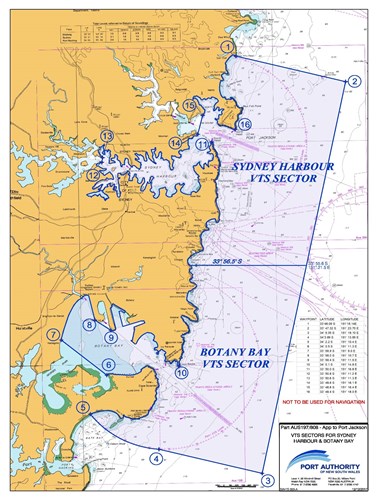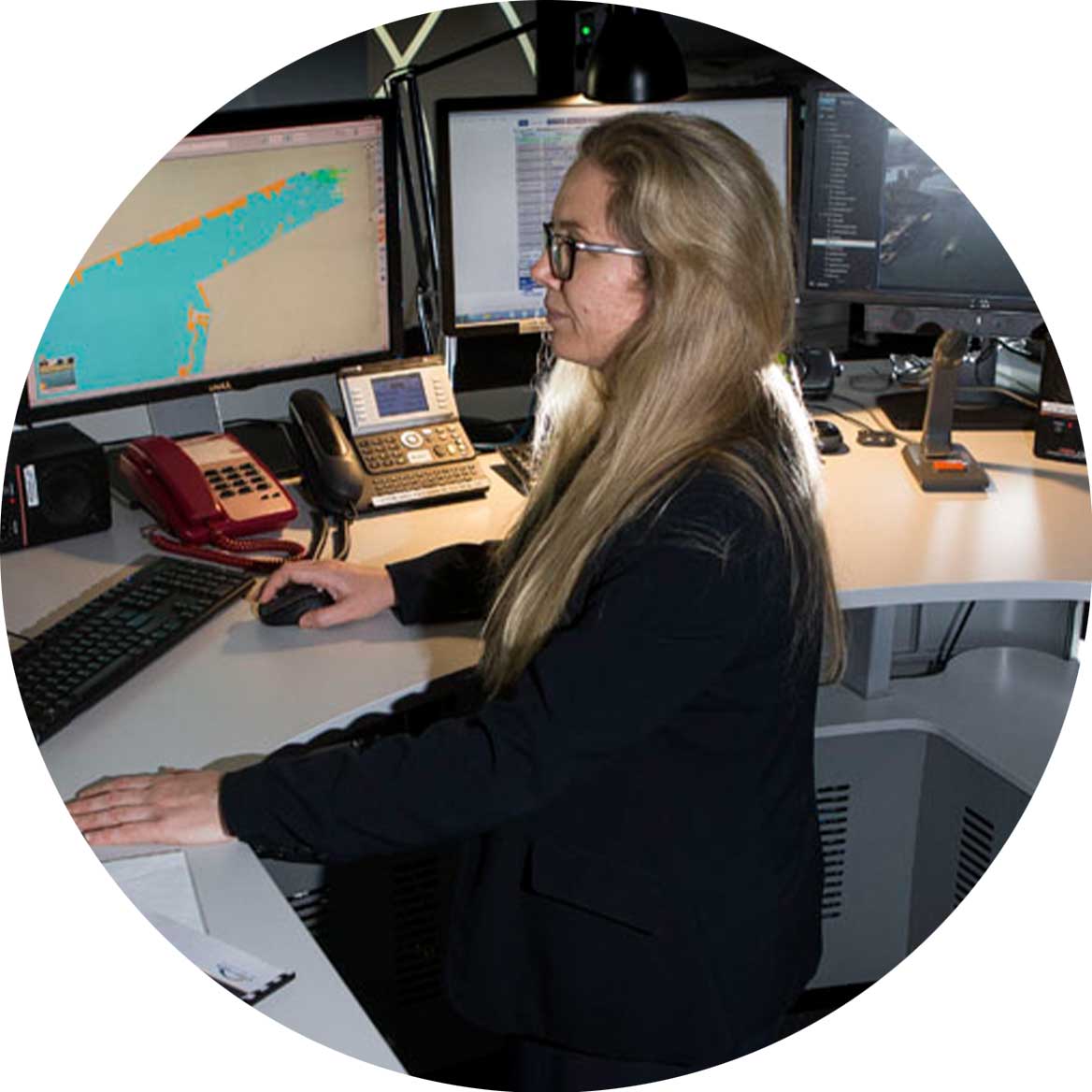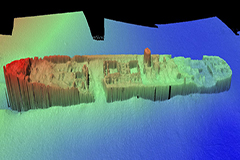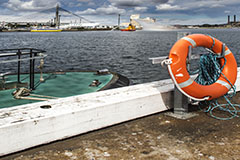The Port Authority of New South Wales provides a Vessel Traffic Service with the call sign, 'Sydney VTS' which monitors the movement of participating vessels within the VTS area of Sydney Harbour and Botany Bay.
VHF:
Sydney Harbour VHF Channel 13
Botany Bay VHF Channel 12
All vessels within Botany Bay and Sydney Harbour navigating or at anchor or secured to a buoy, shall at all times maintain a listening watch on VHF channel 12 or 13 respectively.
The objective of Sydney VTS is to:
- Aid the mariner in the safe and efficient use of navigable waters within the VTS area;
- Communicate timely and important information to vessels participating in the monitoring programme to support their on-board decision making process;
- Assist in providing a harmonious interface between recreational and commercial shipping; and
- Provide an effective communications base for the response to any safety or pollution incident.
Sydney VTS provides the following services as described in the International Association of Marine Aids to Navigation and Lighthouse Authority (IALA) Guidelines and Recommendations:
- Information Service (INS): a service that provides essential and timely information to assist the on board decision-making process, and
- Traffic Organisation Service (TOS): a service to prevent the development of dangerous maritime traffic situations and to provide for the safe and efficient movement of vessel traffic within the VTS Area.
- Navigational Assistance Service (NAS): a service to assist on-board decision making and to monitor its effects, especially in difficult navigational or meteorological circumstances or in the case of defects or deficiencies.
Sydney VTS provides a continuous service to monitor and manage the movement of participating vessels within the VTS area.
Vessels operating or intending to operate within the Sydney VTS area should be fully conversant with the Harbour Master Directions for Sydney Harbour and Botany Bay.
VTS area approved by AMSA - Sydney VTS

Please refer to Harbour Master Directions for Sydney Harbour and Botany Bay for a more detailed description of the Sydney VTS area and its sectors.
The Harbour Master under section 88 of the Marine Safety Act 1998 directs that all vessels in length of 30m or over are required to participate in the Vessel Traffic Service (VTS).
Participating Vessels means all vessels of LOA 30m or over and vessels towing or pushing a tow, where the combined length of the tug and tow is equal to or greater than 30m. These vessels are required to participate in the Vessel Traffic Service.
Sydney VTS will assist in:
- Safety of life at sea
- Safety of navigation
- Efficiency of vessel traffic movement
- Protection of the marine environment
- Supporting maritime security
- Supporting law enforcement and
- Protection of adjacent communities and infrastructure
Information and Navigation broadcasts transmitted by Sydney VTS provide:
- Navigational warnings and weather forecast;
- Seagoing ship movements expected for the next two hours;
- Current weather, wave height and tidal conditions;
Broadcast times are:
Botany Bay via VHF channel 12,
- 0005, 0205, 0405, 0605, 0805, 1005, 1205, 1405, 1605, 1805, 2005 & 2205.
Sydney Harbour via VHF channel 13,
- 0105, 0305, 0505, 0705, 0905, 1105, 1305, 1505, 1705, 1905, 2105 & 2305.
Sydney VTS, as Coast Radio Sydney also broadcasts navigational and weather warnings on VHF Channel 67 at 0736 and 1736 hours daily; and monitors VHF 16 for distress urgency and safety messages. Coast Radio Sydney is part of the State and Territory Coast Radio Network servicing the recreational boating community.
Sydney VTS is, at all times, under the control of a Duty VTS Manager, who is responsible for the management of vessel movements within the VTS areas.
The Duty VTS Manager is delegated by the Harbour Master to exercise the power, authority, function and duty of the Harbour Master under sections 88, 89, 91 of the Marine Safety Act 1998.
Under this delegation the Duty VTS Manager may direct the navigation of vessels in Sydney Harbour and Botany Bay.
In this capacity the Duty VTS Manager authorises:
- Traffic clearance /denial of entry or departure of vessels, and vessel movements to anchorages or moorings, within the VTS areas
- Passing relevant information to vessels moving within the ports to assist with the safe navigation of such vessels
- Warnings to vessels within the ports when they may affect the security of such vessels.
All participating vessels, except ferries and commercial vessels on passenger carrying services running to scheduled time, shall seek clearance to enter or move within the VTS area from Sydney VTS 15 minutes before being removed from a berth, buoy or anchorage within the VTS areas.
Participating vessels required to report to Sydney VTS when passing reporting points as per Harbour Master Directions are as follows:
- All vessels with a pilot engaged.
- Any vessel with an exempt master.
- All Bunker tankers.
- Any Vessel that is considered to have reduced manoeuvrability characteristics, which will include:
- Square Rig and Tall ships.
- Vessels engaged in Towing operations
- Any vessel greater than 30 meters in length, which does not transmit AIS information, and
not engaged on a routine ferry service.
All other vessels shall remain in radio communication, being ready to give a position report or inform Sydney VTS of the vessels intentions. Also to take such direction or advice as Sydney VTS deem necessary.
Additionally, participating vessels are required to report to Sydney VTS in the following circumstances:
- Notification of ETA;
- When five miles from the Pilot Boarding Place, where applicable;
- To request clearance to enter the VTS Area
- When transiting between the Botany and Sydney VTS Sectors
- When passing a reporting position;
- When anchored or arrived;
- If disabled, leaking, on fire or has been on fire;
- If involved in collision, grounding, close quarters situation;
- When requesting clearance to depart;
- When requesting clearance to proceed;
- When commencing and completing bunker operations;
- When commencing and completing work that requires a work permit;
- When port safety or the environment may be compromised or the Master considers a report is warranted.
Section 214 of the Navigation Act 2012 (Liability of master or owner under vessel traffic service arrangements) states that:
- The master of a vessel is not relieved from responsibility for the conduct and navigation of the vessel merely because the vessel is subject to vessel traffic service arrangements.
- A requirement under a law of the Commonwealth or of a State or Territory that vessel traffic service arrangements be complied with does not affect the liability of the owner or master of a vessel that complies with such arrangements for:
a) loss or damage caused by the vessel; or
b) loss or damage caused by a fault of the navigation of the vessel
Call Sign: Sydney VTS
Telephone: 02 9296 4999
Email: [email protected]
VHF: Sydney Harbour VHF Channel 13
Botany Bay VHF Channel 12
All vessels within Botany Bay and Sydney Harbour navigating or at anchor or secured to a buoy, shall at all times maintain a listening watch on VHF channel 12 or 13 respectively.
Compliance:
Master of any vessel within Sydney Harbour and Botany Bay shall:
a) Comply with these directions and any other direction which may be given by the Harbour Master;
b) Comply with the requirements of marine legislation;
c) Navigate in accordance with the Convention on the International Regulations for Preventing Collisions at Sea published 20 October 1972, as modified by Schedule 4 to the Marine Safety Act 1998 and in force for Australia from time to time.
The Master of any participating vessel within the VTS Area shall comply with the provisions of AMSA Marine Order 64 (Vessel Traffic Services). The Master must:
- Give to a VTS authority each report or any information the VTS authority requires the master to provide.
- Comply with each instruction for the movement of a the vessel given by the VTS Authority







